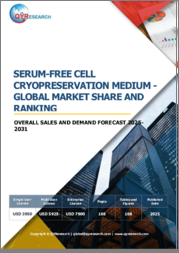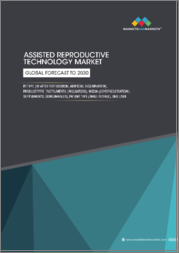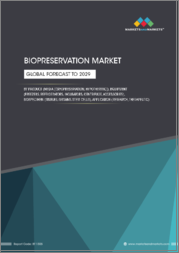
|
시장보고서
상품코드
1344319
세포 동결보존 시장 : 유형별, 용도별, 최종사용자별 - 세계 기회 분석 및 산업 예측(2023-2032년)Cell Cryopreservation Market By Type, By Application, By End User : Global Opportunity Analysis and Industry Forecast, 2023-2032 |
||||||
Allied Market Research가 발행한 '세포 동결보존 시장' 조사 보고서에 따르면, 세포 동결보존 시장은 2022년 103억 달러로 평가되며 2023년부터 2032년까지 22.2%의 CAGR로 성장하여, 2032년에는 766억 달러에 달할 것으로 추정됩니다.
세포 동결보존은 세포를 초저온에서 냉동 보존하여 세포의 생존 능력과 기능을 장기간 유지하는 과정입니다. 이 기술을 통해 세포를 저장하고 나중에 해동하여 연구, 의료 및 기타 용도로 사용할 수 있습니다. 이 연구는 줄기세포, 난 모세포, 정자 세포 및 기타 용도를 대상으로 합니다. 또한 제약회사, 생명공학 회사, 연구기관 등이 주요 최종사용자입니다.

세계 세포 동결보존 시장의 성장은 난자 동결 주기 수의 증가와 함께 여성 불임의 증가가 주요 요인으로 작용하고 있으며, The Society for Assisted Reproductive Technology(보조생식기술학회)에 따르면, 미국에서는 2020년부터 2021년까지 난자 동결 주기가 31% 증가한 것으로 보고되고 있습니다. 또한, 바이오뱅크의 증가는 세포 동결보존 시장의 성장을 촉진할 것으로 예상됩니다. 바이오뱅크는 생물의학 연구, 신약개발, 개인 맞춤형 의료를 촉진하는 데 있어 매우 중요한 역할을 하고 있어 주목받고 있습니다. 바이오뱅크 리소스 센터에 따르면, 2023년 현재 캐나다와 국제 바이오뱅크를 포함해 340개의 바이오뱅크가 등록되어 있습니다.
또한, Journal of Biopreservation and Biobanking에 따르면, 2022년에는 17개국 641개 바이오뱅크가 BBMRI의 디렉토리에 등록될 것으로 보고되고 있다(2021년 2월 12일 기준). 바이오뱅킹 기술의 발전과 더 크고 종합적인 바이오뱅크의 설립에 따라 효율적이고 신뢰할 수 있는 세포 동결보존법에 대한 수요가 크게 증가하고 있습니다. 또한, 제약 및 생명공학 산업의 R&D 활동 증가, R&D 활동에 대한 정부 지원 증가, 암 및 파킨슨병과 같은 만성 질환의 유병률 증가가 시장 성장을 촉진하고 있습니다.
의료자원서비스국에 따르면 2023년 미국의 기증자 등록에는 900만 명 이상의 잠재적 기증자가 포함되어 있는 것으로 보고됐습니다. 또한 국립의학도서관에 따르면 2022년에는 망막질환, 파킨슨병, 헌팅턴병, 척수손상, 심근경색, 제1형 당뇨병 등 다양한 질병을 치료하기 위해 배아줄기세포를 이용한 다양한 전임상 연구 활동이 진행되고 있는 것으로 보고됐습니다. 또한 인도 정부는 인도 의학연구위원회(ICMR), 생명공학부(DBT), 과학기술부(DST) 등 국가 지원기관을 통해 기초연구뿐만 아니라 임상연구를 지원하는 등 다양한 부처와 기관을 통해 줄기세포 연구를 진행하고 있습니다.
Regulatory Affairs Professionals Society에 따르면 2021년에는 약 2,754개의 클리닉이 줄기세포 치료를 제공할 것으로 예상됩니다. 그 결과, 줄기세포 치료에 대한 수요 증가는 세포 동결보존 시장의 중요한 촉진요인으로 작용하고 있습니다. 또한, 개인 맞춤형 의료에 대한 수요의 급증은 세포 동결보존 시장의 중요한 촉진요인으로 작용할 것으로 예상됩니다. 면역세포 기반 면역치료, 인공세포치료와 같은 세포 기반 치료법은 개인 맞춤형 치료의 접근법으로 연구되고 있습니다. 냉동보존은 면역세포를 포함한 환자 특이적 세포의 장기 보존을 가능하게 하여 개인 맞춤형 치료법 개발에 활용될 수 있습니다.
이러한 세포를 저장함으로써 냉동 보존은 환자별 치료에 필요한 시점에 사용할 수 있도록 보장합니다. 개인 맞춤형 의료에 대한 관심이 높아지면서 세포 동결보존 방법과 보존 시설에 대한 수요도 동시에 증가하여 세계 시장 성장을 촉진하고 있습니다. 또한, 불임률의 증가도 시장 성장에 큰 기여를 하고 있습니다. 그러나 세포 동결보존의 대체 요법의 가용성과 보존 절차의 높은 유지비용은 시장 성장을 저해하는 요인으로 작용하고 있습니다.
목차
제1장 서론
제2장 주요 요약
제3장 시장 개요
- 시장 정의와 범위
- 주요 조사 결과
- 영향요인
- 주요 투자 기회
- Porter's Five Forces 분석
- 시장 역학
- 성장 촉진요인
- 난자 동결 주기 증가
- 줄기세포 연구개발 활동 증가
- 바이오뱅크 수 증가와 맞춤형 의료 수요 급증
- 성장 억제요인
- 세포 동결보존 대체 요법 이용 가능성
- 기회
- 연구개발 활동에 대한 정부 지원 증가
- 다양한 세포를 보존하기 위한 신규 제품의 개발에 주력하는 제조업체 증가
- 성장 촉진요인
- COVID-19에 의한 시장에 대한 영향 분석
- 특허 상황
제4장 세포 동결보존 시장 : 유형별
- 동결보존 매체
- 세포 동결보존 시장 : 에이전트별
- 장비
- 세포 동결보존 시장 : 유형별
제5장 세포 동결보존 시장 : 용도별
- 줄기세포
- 난모세포
- 정자세포
- 기타
제6장 세포 동결보존 시장 : 최종사용자별
- 제약·바이오테크놀러지 기업
- 연구기관
- 기타
제7장 세포 동결보존 시장 : 지역별
- 북미
- 미국
- 캐나다
- 멕시코
- 유럽
- 독일
- 프랑스
- 영국
- 이탈리아
- 스페인
- 기타 유럽
- 아시아태평양
- 일본
- 중국
- 인도
- 호주
- 한국
- 말레이시아
- 기타 아시아태평양
- 라틴아메리카, 중동 및 아프리카
- 브라질
- 남아프리카공화국
- 사우디아라비아
- 기타 지역
제8장 경쟁 상황
- 서론
- 주요 성공 전략
- 주요 10개사 제품 매핑
- 경쟁 대시보드
- 경쟁 히트맵
- 주요 기업의 포지셔닝, 2022년
제9장 기업 개요
- Creative Biolabs
- Eppendorf Corporate
- Lonza
- PromoCell GmbH
- Sartorius AG
- BioLife Solutions, Inc.
- Danaher Corporation
- Thermo Fisher Scientific Inc.
- HiMedia Laboratories
- Merck Group KGaA
According to a new report published by Allied Market Research, titled, "Cell Cryopreservation Market," The cell cryopreservation market was valued at $10.3 billion in 2022, and is estimated to reach $76.6 billion by 2032, growing at a CAGR of 22.2% from 2023 to 2032. Cell cryopreservation is the process of freezing and storing cells at ultra-low temperatures to preserve their viability and functionality for extended periods. This technique allows cells to be stored and later thawed for use in research, medical treatments, or other applications. The applications covered in t study include stem cells, oocytes cells, sperm cells, and others. In addition, pharmaceutical & biotechnology company, research institute, and others are the major end users detailed in the report.

The growth of the global cell cryopreservation market is majorly driven by increase in infertility among women coupled with rise in number of egg freezing cycles. According to The Society for Assisted Reproductive Technology, it was reported that the egg freezing cycle increased by 31% from 2020 to 2021 in the U.S. In addition, rise in presence of biobanks is anticipated to drive the growth of the cell cryopreservation market. Biobanking has gained prominence due to its crucial role in facilitating biomedical research, drug discovery, and personalized medicine. According to the Biobank Resource Center, as of 2023, there are 340 registered biobanks, including both Canadian and international biobanks.
Moreover, according to the Journal of Biopreservation and Biobanking, in 2022, it was reported that the BBMRI directory listed 641 biobanks from 17 countries (as of February 12, 2021). With the advancement of biobanking technologies and the establishment of larger and more comprehensive biobanks, the demand for efficient and reliable cell cryopreservation methods has grown significantly. Furthermore, increase in R&D activities in pharmaceutical and biotechnology industries, rise in government support for R&D activities, and increase in prevalence of chronic diseases such as cancer and Parkinson's propel the growth of the market.
According to Health Resource and Service Administration, in 2023, it was reported that the donor registry contains more than 9 million potential donors in the U.S. Furthermore, as per the National Library of Medicine, in 2022, it was reported that various preclinical research activities are conducted in embryonic stem cells for the treatment of wide range of disease such as retinal diseases, Parkinson's disease, Huntington's disease, spinal cord injury, myocardial infarction, and type 1 diabetes. In addition, the Government of India conducted stem cell research through various departments and institutions by supporting basic as well as clinical research through national funding agencies such as the Indian Council of Medical Research (ICMR), Department of Biotechnology (DBT), and Department of Science and Technology (DST).
Furthermore, according to Regulatory Affairs Professionals Society, in 2021, there were around 2,754 clinics engaged in providing stem cell therapies. Consequently, the growing demand for stem cell therapies acts as a significant driver of the cell cryopreservation market. In addition, surge in demand for personalized medicines is expected to act as a significant driver of the cell cryopreservation market. Cell-based therapies, such as immune cell-based immunotherapies and engineered cell therapies, are being explored as personalized treatment approaches. Cryopreservation enables long-term storage of patient-specific cells, including immune cells, which can be used in the development of personalized therapies.
By preserving these cells, cryopreservation ensures their availability when needed for patient-specific treatments. As the interest in personalized medicine continues to grow, the demand for cell cryopreservation methods and storage facilities increases simultaneously, thereby augmenting the growth of the global market. Furthermore, rise in infertility rates notably contributes toward the growth of the market. However, availability of alternative therapies for cell cryopreservation and high maintenance cost in storage procedure hinder the growth of the market.
- The global cell cryopreservation market is segmented into type, application, end user, and region. On the basis of type, the market is bifurcated into cryopreservation media and equipment. The cryopreservation media segment is further sub segmented into ethylene glycol, dimethyl sulfoxide, glycerol, and others.. The equipment segment is subsegmented into freezers, liquid nitrogen supply tanks, and others.
- Depending on application, the market is classified into stem cells, oocytes cells, sperm cells, and others. By end user, it is segregated into pharmaceutical & biotechnology company, research institute, and others. Region wise, it is studied across North America (the U.S., Canada, and Mexico), Europe (Germany, France, UK, Italy, Spain, and rest of Europe), Asia-Pacific (China, Japan, Australia, India, and rest of Asia-Pacific), and LAMEA (Brazil, South Africa, Saudi Arabia, and rest of LAMEA). The major companies profiled in the report include: Merck Group KGaA, HiMedia Laboratories, Thermo Fisher Scientific Inc. , Eppendorf Corporate, BioLife Solutions, Inc., Lonza, Sartorius AG, Creative Biolabs, Sartorius AG, and PromoCell GmbH.
Key Benefits For Stakeholders
- This report provides a quantitative analysis of the market segments, current trends, estimations, and dynamics of the cell cryopreservation market analysis from 2021 to 2031 to identify the prevailing cell cryopreservation market opportunities.
- The market research is offered along with information related to key drivers, restraints, and opportunities.
- Porter's five forces analysis highlights the potency of buyers and suppliers to enable stakeholders make profit-oriented business decisions and strengthen their supplier-buyer network.
- In-depth analysis of the cell cryopreservation market segmentation assists to determine the prevailing market opportunities.
- Major countries in each region are mapped according to their revenue contribution to the global market.
- Market player positioning facilitates benchmarking and provides a clear understanding of the present position of the market players.
- The report includes the analysis of the regional as well as global cell cryopreservation market trends, key players, market segments, application areas, and market growth strategies.
Key Market Segments
By Type
- Cryopreservation media
- Agent
- Ethylene glycol
- Dimethyl sulfoxide
- Glycerol
- Others
- Equipment
- Type
- Freezers
- Liquid nitrogen supply tanks
- Others
By Application
- Stem cells
- Oocytes cells
- Sperm cells
- Others
By End User
- Pharmaceutical and biotechnology company
- Research institute
- Others
By Region
- North America
- U.S.
- Canada
- Mexico
- Europe
- Germany
- France
- UK
- Italy
- Spain
- Rest of Europe
- Asia-Pacific
- Japan
- China
- India
- Australia
- South Korea
- Malaysia
- Rest of Asia-Pacific
- LAMEA
- Brazil
- South Africa,
- Saudi Arabia
- Rest of LAMEA
Key Market Players:
- BioLife Solutions, Inc.
- Creative Biolabs
- Danaher Corporation
- Eppendorf Corporate
- HiMedia Laboratories
- Lonza
- Merck Group KGaA
- PromoCell GmbH
- Sartorius AG
- Thermo Fisher Scientific Inc.
TABLE OF CONTENTS
CHAPTER 1: INTRODUCTION
- 1.1. Report description
- 1.2. Key market segments
- 1.3. Key benefits to the stakeholders
- 1.4. Research Methodology
- 1.4.1. Primary research
- 1.4.2. Secondary research
- 1.4.3. Analyst tools and models
CHAPTER 2: EXECUTIVE SUMMARY
- 2.1. CXO Perspective
CHAPTER 3: MARKET OVERVIEW
- 3.1. Market definition and scope
- 3.2. Key findings
- 3.2.1. Top impacting factors
- 3.2.2. Top investment pockets
- 3.3. Porter's five forces analysis
- 3.3.1. Low bargaining power of suppliers
- 3.3.2. Low threat of new entrants
- 3.3.3. Low threat of substitutes
- 3.3.4. Low intensity of rivalry
- 3.3.5. Low bargaining power of buyers
- 3.4. Market dynamics
- 3.4.1. Drivers
- 3.4.1.1. Increase in number of egg freezing cycles
- 3.4.1.2. Increase in research and development activities for stem cells
- 3.4.1.3. Rise in number of biobanks and surge in demand for personalized medicines
- 3.4.1. Drivers
- 3.4.2. Restraints
- 3.4.2.1. Availability of alternative therapies for cell cryopreservation
- 3.4.3. Opportunities
- 3.4.3.1. Increase in government support for research and development activities
- 3.4.3.2. Rise in focus of manufacturers on developing novel products for preserving various cells
- 3.5. COVID-19 Impact Analysis on the market
- 3.6. Patent Landscape
CHAPTER 4: CELL CRYOPRESERVATION MARKET, BY TYPE
- 4.1. Overview
- 4.1.1. Market size and forecast
- 4.2. Cryopreservation media
- 4.2.1. Key market trends, growth factors and opportunities
- 4.2.2. Market size and forecast, by region
- 4.2.3. Market share analysis by country
- 4.2.4. Cryopreservation media Cell Cryopreservation Market by Agent
- 4.3. Equipment
- 4.3.1. Key market trends, growth factors and opportunities
- 4.3.2. Market size and forecast, by region
- 4.3.3. Market share analysis by country
- 4.3.4. Equipment Cell Cryopreservation Market by Type
CHAPTER 5: CELL CRYOPRESERVATION MARKET, BY APPLICATION
- 5.1. Overview
- 5.1.1. Market size and forecast
- 5.2. Stem cells
- 5.2.1. Key market trends, growth factors and opportunities
- 5.2.2. Market size and forecast, by region
- 5.2.3. Market share analysis by country
- 5.3. Oocytes cells
- 5.3.1. Key market trends, growth factors and opportunities
- 5.3.2. Market size and forecast, by region
- 5.3.3. Market share analysis by country
- 5.4. Sperm cells
- 5.4.1. Key market trends, growth factors and opportunities
- 5.4.2. Market size and forecast, by region
- 5.4.3. Market share analysis by country
- 5.5. Others
- 5.5.1. Key market trends, growth factors and opportunities
- 5.5.2. Market size and forecast, by region
- 5.5.3. Market share analysis by country
CHAPTER 6: CELL CRYOPRESERVATION MARKET, BY END USER
- 6.1. Overview
- 6.1.1. Market size and forecast
- 6.2. Pharmaceutical and biotechnology company
- 6.2.1. Key market trends, growth factors and opportunities
- 6.2.2. Market size and forecast, by region
- 6.2.3. Market share analysis by country
- 6.3. Research institute
- 6.3.1. Key market trends, growth factors and opportunities
- 6.3.2. Market size and forecast, by region
- 6.3.3. Market share analysis by country
- 6.4. Others
- 6.4.1. Key market trends, growth factors and opportunities
- 6.4.2. Market size and forecast, by region
- 6.4.3. Market share analysis by country
CHAPTER 7: CELL CRYOPRESERVATION MARKET, BY REGION
- 7.1. Overview
- 7.1.1. Market size and forecast By Region
- 7.2. North America
- 7.2.1. Key trends and opportunities
- 7.2.2. Market size and forecast, by Type
- 7.2.3. Market size and forecast, by Application
- 7.2.4. Market size and forecast, by End User
- 7.2.5. Market size and forecast, by country
- 7.2.5.1. U.S.
- 7.2.5.1.1. Key market trends, growth factors and opportunities
- 7.2.5.1.2. Market size and forecast, by Type
- 7.2.5.1.3. Market size and forecast, by Application
- 7.2.5.1.4. Market size and forecast, by End User
- 7.2.5.2. Canada
- 7.2.5.2.1. Key market trends, growth factors and opportunities
- 7.2.5.2.2. Market size and forecast, by Type
- 7.2.5.2.3. Market size and forecast, by Application
- 7.2.5.2.4. Market size and forecast, by End User
- 7.2.5.3. Mexico
- 7.2.5.3.1. Key market trends, growth factors and opportunities
- 7.2.5.3.2. Market size and forecast, by Type
- 7.2.5.3.3. Market size and forecast, by Application
- 7.2.5.3.4. Market size and forecast, by End User
- 7.3. Europe
- 7.3.1. Key trends and opportunities
- 7.3.2. Market size and forecast, by Type
- 7.3.3. Market size and forecast, by Application
- 7.3.4. Market size and forecast, by End User
- 7.3.5. Market size and forecast, by country
- 7.3.5.1. Germany
- 7.3.5.1.1. Key market trends, growth factors and opportunities
- 7.3.5.1.2. Market size and forecast, by Type
- 7.3.5.1.3. Market size and forecast, by Application
- 7.3.5.1.4. Market size and forecast, by End User
- 7.3.5.2. France
- 7.3.5.2.1. Key market trends, growth factors and opportunities
- 7.3.5.2.2. Market size and forecast, by Type
- 7.3.5.2.3. Market size and forecast, by Application
- 7.3.5.2.4. Market size and forecast, by End User
- 7.3.5.3. UK
- 7.3.5.3.1. Key market trends, growth factors and opportunities
- 7.3.5.3.2. Market size and forecast, by Type
- 7.3.5.3.3. Market size and forecast, by Application
- 7.3.5.3.4. Market size and forecast, by End User
- 7.3.5.4. Italy
- 7.3.5.4.1. Key market trends, growth factors and opportunities
- 7.3.5.4.2. Market size and forecast, by Type
- 7.3.5.4.3. Market size and forecast, by Application
- 7.3.5.4.4. Market size and forecast, by End User
- 7.3.5.5. Spain
- 7.3.5.5.1. Key market trends, growth factors and opportunities
- 7.3.5.5.2. Market size and forecast, by Type
- 7.3.5.5.3. Market size and forecast, by Application
- 7.3.5.5.4. Market size and forecast, by End User
- 7.3.5.6. Rest of Europe
- 7.3.5.6.1. Key market trends, growth factors and opportunities
- 7.3.5.6.2. Market size and forecast, by Type
- 7.3.5.6.3. Market size and forecast, by Application
- 7.3.5.6.4. Market size and forecast, by End User
- 7.4. Asia-Pacific
- 7.4.1. Key trends and opportunities
- 7.4.2. Market size and forecast, by Type
- 7.4.3. Market size and forecast, by Application
- 7.4.4. Market size and forecast, by End User
- 7.4.5. Market size and forecast, by country
- 7.4.5.1. Japan
- 7.4.5.1.1. Key market trends, growth factors and opportunities
- 7.4.5.1.2. Market size and forecast, by Type
- 7.4.5.1.3. Market size and forecast, by Application
- 7.4.5.1.4. Market size and forecast, by End User
- 7.4.5.2. China
- 7.4.5.2.1. Key market trends, growth factors and opportunities
- 7.4.5.2.2. Market size and forecast, by Type
- 7.4.5.2.3. Market size and forecast, by Application
- 7.4.5.2.4. Market size and forecast, by End User
- 7.4.5.3. India
- 7.4.5.3.1. Key market trends, growth factors and opportunities
- 7.4.5.3.2. Market size and forecast, by Type
- 7.4.5.3.3. Market size and forecast, by Application
- 7.4.5.3.4. Market size and forecast, by End User
- 7.4.5.4. Australia
- 7.4.5.4.1. Key market trends, growth factors and opportunities
- 7.4.5.4.2. Market size and forecast, by Type
- 7.4.5.4.3. Market size and forecast, by Application
- 7.4.5.4.4. Market size and forecast, by End User
- 7.4.5.5. South Korea
- 7.4.5.5.1. Key market trends, growth factors and opportunities
- 7.4.5.5.2. Market size and forecast, by Type
- 7.4.5.5.3. Market size and forecast, by Application
- 7.4.5.5.4. Market size and forecast, by End User
- 7.4.5.6. Malaysia
- 7.4.5.6.1. Key market trends, growth factors and opportunities
- 7.4.5.6.2. Market size and forecast, by Type
- 7.4.5.6.3. Market size and forecast, by Application
- 7.4.5.6.4. Market size and forecast, by End User
- 7.4.5.7. Rest of Asia-Pacific
- 7.4.5.7.1. Key market trends, growth factors and opportunities
- 7.4.5.7.2. Market size and forecast, by Type
- 7.4.5.7.3. Market size and forecast, by Application
- 7.4.5.7.4. Market size and forecast, by End User
- 7.5. LAMEA
- 7.5.1. Key trends and opportunities
- 7.5.2. Market size and forecast, by Type
- 7.5.3. Market size and forecast, by Application
- 7.5.4. Market size and forecast, by End User
- 7.5.5. Market size and forecast, by country
- 7.5.5.1. Brazil
- 7.5.5.1.1. Key market trends, growth factors and opportunities
- 7.5.5.1.2. Market size and forecast, by Type
- 7.5.5.1.3. Market size and forecast, by Application
- 7.5.5.1.4. Market size and forecast, by End User
- 7.5.5.2. South Africa,
- 7.5.5.2.1. Key market trends, growth factors and opportunities
- 7.5.5.2.2. Market size and forecast, by Type
- 7.5.5.2.3. Market size and forecast, by Application
- 7.5.5.2.4. Market size and forecast, by End User
- 7.5.5.3. Saudi Arabia
- 7.5.5.3.1. Key market trends, growth factors and opportunities
- 7.5.5.3.2. Market size and forecast, by Type
- 7.5.5.3.3. Market size and forecast, by Application
- 7.5.5.3.4. Market size and forecast, by End User
- 7.5.5.4. Rest of LAMEA
- 7.5.5.4.1. Key market trends, growth factors and opportunities
- 7.5.5.4.2. Market size and forecast, by Type
- 7.5.5.4.3. Market size and forecast, by Application
- 7.5.5.4.4. Market size and forecast, by End User
CHAPTER 8: COMPETITIVE LANDSCAPE
- 8.1. Introduction
- 8.2. Top winning strategies
- 8.3. Product Mapping of Top 10 Player
- 8.4. Competitive Dashboard
- 8.5. Competitive Heatmap
- 8.6. Top player positioning, 2022
CHAPTER 9: COMPANY PROFILES
- 9.1. Creative Biolabs
- 9.1.1. Company overview
- 9.1.2. Key Executives
- 9.1.3. Company snapshot
- 9.1.4. Operating business segments
- 9.1.5. Product portfolio
- 9.2. Eppendorf Corporate
- 9.2.1. Company overview
- 9.2.2. Key Executives
- 9.2.3. Company snapshot
- 9.2.4. Operating business segments
- 9.2.5. Product portfolio
- 9.2.6. Business performance
- 9.2.7. Key strategic moves and developments
- 9.3. Lonza
- 9.3.1. Company overview
- 9.3.2. Key Executives
- 9.3.3. Company snapshot
- 9.3.4. Operating business segments
- 9.3.5. Product portfolio
- 9.3.6. Business performance
- 9.4. PromoCell GmbH
- 9.4.1. Company overview
- 9.4.2. Key Executives
- 9.4.3. Company snapshot
- 9.4.4. Operating business segments
- 9.4.5. Product portfolio
- 9.5. Sartorius AG
- 9.5.1. Company overview
- 9.5.2. Key Executives
- 9.5.3. Company snapshot
- 9.5.4. Operating business segments
- 9.5.5. Product portfolio
- 9.5.6. Business performance
- 9.6. BioLife Solutions, Inc.
- 9.6.1. Company overview
- 9.6.2. Key Executives
- 9.6.3. Company snapshot
- 9.6.4. Operating business segments
- 9.6.5. Product portfolio
- 9.6.6. Business performance
- 9.6.7. Key strategic moves and developments
- 9.7. Danaher Corporation
- 9.7.1. Company overview
- 9.7.2. Key Executives
- 9.7.3. Company snapshot
- 9.7.4. Operating business segments
- 9.7.5. Product portfolio
- 9.7.6. Business performance
- 9.7.7. Key strategic moves and developments
- 9.8. Thermo Fisher Scientific Inc.
- 9.8.1. Company overview
- 9.8.2. Key Executives
- 9.8.3. Company snapshot
- 9.8.4. Operating business segments
- 9.8.5. Product portfolio
- 9.8.6. Business performance
- 9.8.7. Key strategic moves and developments
- 9.9. HiMedia Laboratories
- 9.9.1. Company overview
- 9.9.2. Key Executives
- 9.9.3. Company snapshot
- 9.9.4. Operating business segments
- 9.9.5. Product portfolio
- 9.10. Merck Group KGaA
- 9.10.1. Company overview
- 9.10.2. Key Executives
- 9.10.3. Company snapshot
- 9.10.4. Operating business segments
- 9.10.5. Product portfolio
- 9.10.6. Business performance



















